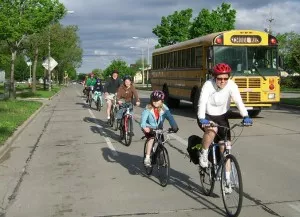
Walking, cycling to school less common today, says UTM professor
In a study released April 5 by Metrolinx, the Greater Toronto and Hamilton Area’s transportation planning agency, UTM geography professor Ron Buliung found a decline among youth in the use of physically active modes of transportation to commute to school over a 25-year period, while the percentage driven to school has doubled.
Buliung looked at regional school transportation data from 1986 to 2011 and found that fewer students were walking or cycling to school, a trend that runs counter to the Metrolinx goal of having 60 per cent of students engage in some form of active commuting to and from school by 2031.
“We have a multi-billion dollar congestion problem in the region,” says Buliung, who has worked with Metrolinx on transportation research for a decade. “We’re dealing with the hangover from the auto century.
“We’re interested in creating a more active commuter workforce, and if we’re looking at a long-term cultural change, it’s important to look at children and young adults, because they are the adult commuters of the future.”
In 1986, 56 per cent of 11- to 13-year olds walked to school and 12 per cent were driven there. Twenty-five years later, the only 39 per cent were walkers, compared to 31 per cent who were driven. Students in the 11 to 13 age group are more likely to walk or cycle than their 14- to 17-year-old counterparts. (Transportation data are not recorded for children under the age of 11).
Buliung’s research also found that students ages 11 to 17 are more likely to be driven to school in the morning than the afternoon and that boys are more likely to use active modes of transportation than girls. These findings are consistent with societal trends toward two parents working – making them unavailable for afternoon car transport – and with personal safety concerns among girls.
These data seem discouraging, given the prevalence of childhood obesity in North America, but Buliung says that although he was “disappointed” by the data, much effort has been made since the turn of this century to increase active transportation.
“In the last five years, we’ve really been gaining ground,” he says. “School boards in Hamilton-Wentworth and Toronto, for example, have created active and safe school travel charters, and Peel Public Health is very interested in active transportation for school and otherwise.”
Metrolinx’s Smart Commute also created the GTHA Active Sustainable School Transportation Hub -- which includes 60 organizations and individuals such as public health units, transportation planners, school boards and parent associations –to help promote and facilitate active school travel and reverse negative trends. They now have the capacity to sponsor programs such as Bike to School Week.
“We want to get this research out into the public arena so we can reach the widest possible audience, have a discussion about the increasingly dominant role of the auto in the lives of our children and see what we can do to get them moving again,” Buliung says.
